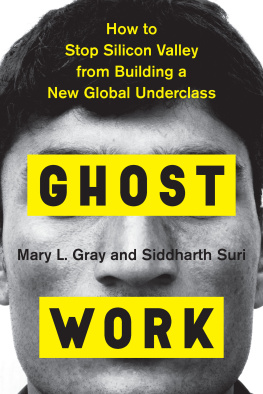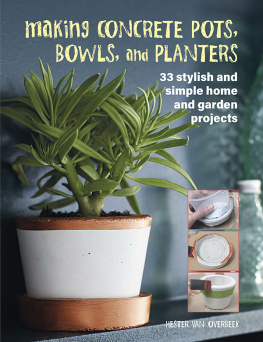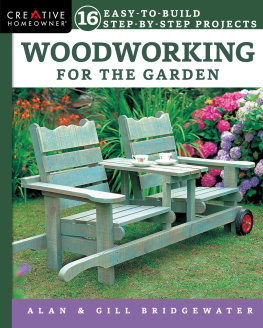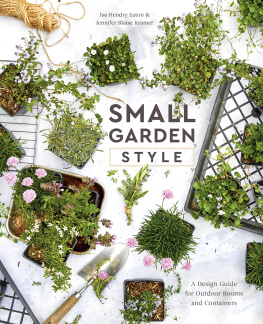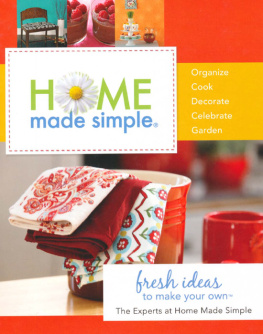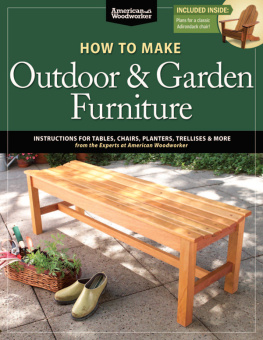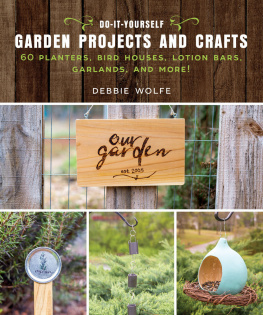
Who would ever believe these gorgeous vertical planters were once attic gable vents?
POTTED
Make Your Own Stylish Garden Containers
ANNETTE GOLITI GUTIERREZ & MARY GRAY
TIMBER PRESS PORTLAND,OREGON
To our wonderful Potted staff, who gave us the peace of mind and support we needed to work on this book wholeheartedlybut especially Sydney Michael, who held together our photography with her positive energy and endless hours of collaboration.

A flying saucer planter made from industrial salad bowls and PVC piping.

Common building materials are transformed into elegant planters by a poolside getaway.
CONTENTS

Our very first design was the Circle Pot, which was inspired by a 1960s hanging ashtray. Here it is planted with silver dollar plant (Xerosicyos danguyi) and Graptoveria Fred Ives.
PREFACE
Whether you are a seasoned homeowner or are just starting out with your first garden patio, outdoor planters are seductive and sultry as they lure you in with their rich colors and clean lines. You can hardly wait to add them to your gardenuntil you see the price tag, which can be out of reach for many budgets. Big-box stores offer better bargains but fewer choices, and many of us are turned off by the idea of having the same thing as everyone else. We want unique products that make a statement. This book will help you boldly go where no planter has gone before by empowering you to create show-stopping containers.
We have owned Potted, a Los Angelesbased outdoor lifestyle brand, for more than a decade. As the creative forces behind the brand, we are always looking for unusual and interesting products geared toward outdoor living to excite and inspire our customers. Its one of the reasons we are a successful business and why many people choose us over the big chain stores. And while we support local artists and think nothing of traveling to find compelling products, what sets us apart are our Potted designsgarden pavers, tile tables, and especially pots (we are called Potted, after all).
So what does this mean for you? Well, our love of design compelled us to write this book, which is filled with inspirational and original ideas to help you make your own planters from everyday materials.
Beyond being affordable, we wanted to create projects that are gorgeous and accessible. You do not need a workshop or countless tools at your disposal to build these planters. We have a bit more expertise with fabrication than the average person, and this knowledge has been invaluable in working out how these projects assemble and whether they are feasible. When coming up with possible ideas, we asked ourselves three questions: is it affordable, are the materials easy to find, and could we do it on our own? If the answer to any of these questions was no, we threw out the idea. Finally, the most important consideration was that the finished product had to look fabulous.
We hope you will find ideas in this book that will excite and energize you to turn your own garden into a Potted oasis. There is something for everyone, from entryway planters crafted from garbage cans to hanging planters made with kitchenware. We have come up with designs we have never seen, and we offer a different spin on some familiar favorites. You can either follow our instructions exactly or, for even more fun, customize them to suit your own personality. And we expect Pinterest and Instagram to virtually explode with all your creations. We cant wait to see them. #pottedstylediy
DO IT YOURSELF BASICS
THINKING CREATIVELY ABOUT EVERYDAY MATERIALS
We conceived most of the ideas in this book while walking through building yards, home-improvement warehouses, and art-supply stores. By asking ourselves What if? as we perused the aisles, all sorts of possibilities came to mind. What if we put a back on that attic gable vent and hung it on the wall? What if we tried doing decoupage outdoors? What if we took a drywall mud pan and put some plants in it? If you allow yourself to see past an objects intended use, new worlds will open up to you.
The projects are organized by materials: concrete, plastic, metal, terra-cotta, and organic. You can do many projects with different materials than we specify. For example, the plastic garbage can could be metal; the terra-cotta planter could be wood. You could take concepts from one project and apply them to anotherdecoupage cinderblocks, anyone? Dont limit yourself to the materials we have presented. When you begin looking at everyday objects with a different eye, you will start to get crazy ideas. Try walking through your garage while wearing your anything-is-possible glasses. What could you do with an old lawn mower? Weve limited our scope to new items you can purchase easily, but that doesnt mean you have to go shopping.

The original idea for this planter came from seeing a pile of cinderblocks in a building yard and wondering, What if?
TOOLS AND TIPS OF THE TRADE
We worked to come up with projects that do not require expensive or difficult-to-use tools. For the few times we couldnt avoid using things like circular saws, we suggest borrowing or renting them (unless you really catch the DIY bug, in which case get your own). And if youre afraid of particular tools, please ask for help. You do not have to do every last thing yourself. When we first started Potted, we were obsessed with tile and wanted to put it on everything (actually, we still do). We bought the least expensive tile saw known to humankind and began trying to figure it out. And even though we both learned to use it and made several tables, we were always a little scared, and we were relieved when we were doing well enough to hire someone to cut tile for us and could focus on design. You dont have to be the master of everything to do these projects.
You will want to use some tools over and over again, and developing a toolkit will come in handy. Here is a list of some must-have items.
ASSORTED DRILL BITS Some people dont realize there are bits to create holes and bits to screw things into objects. Unfortunately, both are referred to as drill bits. For our purposes, a set of assorted wood drill bits will cover most predrilling situations, and a standard two-sided Phillips head or straight head screw bit will cover the rest. Be sure you have a few masonry drill bits. These work for ceramics and concrete and are essential for drilling drainage holes. They get dull pretty quickly if you use them frequently, so be prepared to repurchase once in a while if you become addicted to DIY.
BOX CUTTER Also called a utility knife, this all-around tool works on more than boxes.
BUILDING ADHESIVES There are so many brands and different applications that its important to read labels before you purchase. Look for whether the product is recommended for outdoor use, how long the setup time is (that is, how long you can work with it before it starts to harden), and what material it works best on (plastic, wood, concrete, fabric). Unless you are doing several projects at once, adhesives can be challenging to work with once theyve been opened (another reason to buy the smaller, although more expensive, hand-squeezed tubes).
Next page

